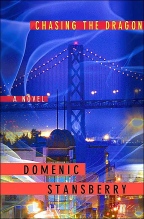Chasing the Dragon
Domenic Stansberry
St. Martin's Minotaur
US Hardcover First
ISBN: 0-312-32467-7
Publication Date: October, 2004
Date Reviewed: November 23, 2004
Reviewed by: Terry D'Auray © 2004

REFERENCES
COLUMNS
|
|
|
Chasing the DragonDomenic StansberrySt. Martin's MinotaurUS Hardcover FirstISBN: 0-312-32467-7Publication Date: October, 2004Date Reviewed: November 23, 2004Reviewed by: Terry D'Auray © 2004 |
|
|
REFERENCES |
COLUMNS |
With 'Chasing the Dragon' Dominic Stansberry launches the first of what's promised to be a series featuring protagonist Dante Mancuso, combining fatalistic hardboiled noir with a little history and a lot of atmosphere. Set in the Bay Area of Northern California, the San Francisco atmosphere is as thick as the San Francisco fog.
Dante is a former San Francisco cop who resigned from the force in disgrace over a contentious and shady investigation. He now works for "The Company", an entity of questionable status, questionable tactics, and one seemingly perched squarely on the center stripe between the legal and the illegal. Using the recent death of his father as rationale, the Company sends Dante back to San Francisco to set up and take out a ring of Chinese heroin dealers. Once there, Dante learns that his father feared someone was out to kill him, a fear made all the more credible by the murder of Dante's uncle a few days later. Dante becomes the chief suspect in his uncle's murder in an investigation conducted by the SFPD's Frank Ying, the same cop sent to probe the threats against Dante's father. Dante now faces two tasks - his job for The Company and the resolution of the murders of his family. To untangle this mess, Dante must tangle with exs - an ex girlfriend, ex SFPD workmates, an ex mayor - and he runs headlong into the very investigation that caused him to leave in the first place. The story ultimately comes full circle, but it doesn't get there following a straight line.
Stansberry anchors both his primary characters and the novel's narrative thread in the rich layers of San Francisco's criminal history and ethnic underworlds. Dante was raised in the Italian neighborhood of North Beach; his father and his uncle were of the old world, ethnically clannish and rooted in the old ways. Dante's return to the house in which he grew up calls up these old ways and old superstitions, with their dark, fatalistic power. The Chinese of nearby Chinatown were the Italian's uneasy neighbors, equally ethnically isolated and clannish, rooted in their own cultural traditions and equally fearful. The distrust and unease between Italian and Chinese, born from their tightly bound ethnic communities, provides the undercurrent of brooding gloom that pervades the novel.
Layered on top of this cultural divide is criminal activity, past and present - drugs, sex, swindles, smuggling, and, of course, murder. Dante ultimately unites with Ying to uncover one evil, only to find that another, and yet another lie beneath. Greed, fear, duplicity and betrayal, family loyalty and family failings, all come full circle.
Stansberry's prose is simple and descriptive; it's also exceptionally evocative. He sets-up his story slowly, backtracking into the past to amplify and enhance the present. The pacing accelerates as the narrative moves on, with ever more rapid twists and turns culminating in a satisfying and haunting conclusion. His story is violent and grim, realistic but not gruesome. 'Chasing the Dragon' successfully embodies all the elements that make up a solid mystery. But the novel stands apart from the merely solid by virtue of its wholly enveloping atmosphere. Stansberry's narrative is moody and shadowy, like a 30s noir film, a chiaroscuro of character, setting and plot. His major characters and primary themes are drawn in charcoaled shades of gray. Stansberry weaves together imagery and intrigue in a noirishly dark story that, when there are no more pages to turn, is concluded, but not over.